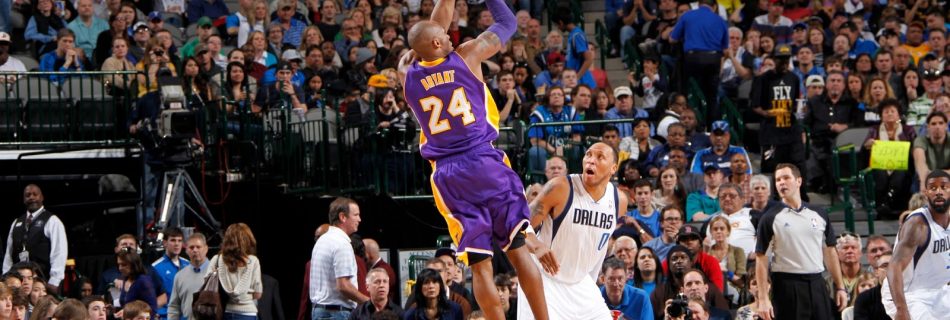Every basketball legend is remembered for a move that became their trademark. Michael Jordan had his mid-range pull-up, Kareem Abdul-Jabbar his skyhook, Dirk Nowitzki his one-legged fadeaway. For Kobe Bryant, it was the fadeaway jumper — a shot that combined technique, timing, and mentality into a nearly unstoppable weapon.
The fadeaway wasn’t just a trick in Kobe’s offensive arsenal. It was a symbol of his obsessive pursuit of mastery, a manifestation of the Mamba Mentality. For two decades, he tormented defenders with this shot, leaving behind not only highlights but also a basketball lesson: greatness is crafted, not given.
What Is the Fadeaway Jumper?
At its core, the fadeaway is a jump shot where the offensive player leans backward, away from the defender, as they release the ball. This backward motion creates separation, making it extremely difficult to block.
On paper, it sounds simple. In reality, it’s one of the hardest shots to execute consistently. It requires:
- Lower body strength to generate lift while moving backward.
- Balance and coordination to stay controlled in mid-air.
- Soft touch and arc to drop the ball over the outstretched hands of defenders.
Kobe turned this challenging move into second nature, making it his go-to option when games were on the line.
Kobe’s Evolution into the Fadeaway
The Young Athlete
In his early years, Kobe relied heavily on athleticism. Explosive first steps, powerful dunks, and aggressive drives defined his game. But he understood that pure athleticism fades with time.
The Transformation
As his career progressed — and especially after battling injuries — Kobe leaned more on skill, footwork, and fundamentals. The fadeaway became his way of extending his dominance, ensuring he could still control the game without needing to outjump or outrun anyone.
The Influence of Michael Jordan
Kobe openly admitted that much of his fadeaway technique was inspired by Michael Jordan. Yet, Kobe’s version had its own flavor — sharper footwork, more angles, and an almost artistic flair. Where Jordan’s fadeaway was brutal efficiency, Kobe’s felt like a performance.
Technical Breakdown of Kobe’s Fadeaway
Kobe’s fadeaway was not a single move but a system of options, all branching from perfect footwork.
- The Pivot Foundation
- Everything started with a strong pivot foot. Whether in the low post or at the elbow, Kobe anchored himself to dictate the direction of the move.
- Shoulder as a Shield
- He often leaned into the defender, using his shoulder to create contact and disguise when he was about to fade. This not only gave him balance but also forced defenders to react late.
- The High Release and Arc
- Kobe’s release point was exceptionally high, paired with a steep arc. Even taller defenders had little chance to contest effectively.
- Footwork Variations
- One-dribble pull-up fadeaway.
- Spin fadeaway off the post-up.
- Step-through counter if the defender bit too hard.
- Repetition and Muscle Memory
- Teammates often recalled Kobe staying in the gym for hours after practice, taking hundreds of fadeaways from every spot on the floor. His goal: eliminate randomness.
Iconic Fadeaway Moments
The fadeaway is forever tied to Kobe’s legacy because of the stage on which he used it:
- 2009 & 2010 NBA Finals – Against Orlando and Boston, Kobe repeatedly went to the fadeaway to punish defenders who couldn’t keep up with his footwork.
- Game-winners in the regular season – The fadeaway became the ultimate clutch weapon, delivering countless buzzer-beaters.
- April 13, 2016 – The Farewell Game – Kobe’s final masterpiece, a 60-point performance against the Utah Jazz, featured fadeaway after fadeaway. Even on his last night, the shot remained his signature.
Beyond Mechanics: The Mental Side
Kobe’s fadeaway was as much about mindset as it was about skill.
- It was a solution when defenses locked down other options.
- It was an expression of creativity, finding new angles even when the defender did everything right.
- It was a statement of willpower, proof that he had mastered the game on his own terms.
This is why the fadeaway wasn’t just a shot — it was a philosophy. It embodied the Mamba Mentality: relentless practice, fearless execution, and trust in the work put in behind the scenes.
Lessons from Kobe’s Fadeaway
What can players, coaches, and fans learn from this signature move?
- For players: Work on footwork and balance. Athleticism is temporary, but fundamentals last a career.
- For coaches: Teach players to create space through technique, not just speed or power.
- For fans: Appreciate basketball not only as competition but also as an art form. Kobe’s fadeaway was a masterpiece in motion.
Fadeaway vs. Other Signature Moves
Kobe’s fadeaway sits in the pantheon of basketball’s greatest weapons:
- Kareem’s skyhook – unstoppable due to reach.
- Dirk’s one-legged fadeaway – impossible angle.
- Kobe’s fadeaway – the perfect balance of power, grace, and repetition.
Each was unique, but Kobe’s stood out for how it blended Jordan’s inspiration with his own relentless perfectionism.
The fadeaway jumper will forever be tied to Kobe Bryant’s legacy. It was the move that carried him through championships, defined his clutch performances, and left an imprint on basketball culture worldwide.
For Kobe, the fadeaway wasn’t just a way to score. It was his signature, his story, his art.
Would you like to see a practical breakdown of how to train the fadeaway — with drills, footwork exercises, and progressions you can bring directly into your workouts? Or maybe a comparative study with Michael Jordan’s fadeaway to highlight the evolution of this iconic move?
👉 Drop your thoughts in the comments, and stay tuned for more deep dives into the moves that shaped basketball history

